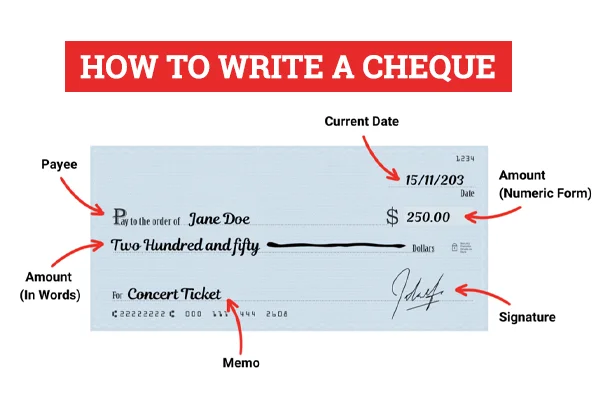How to Write a Cheque
Cheques are still widely used in the UK for various payments, especially when bank transfers or digital transactions aren’t convenient. Knowing how to write a cheque correctly is essential to ensure the payment is processed smoothly and on time. In this guide, we will break down the steps of how to write a cheque while also addressing common queries related to cheque writing.
Cheque Book
When you receive a checkbook, it contains multiple blank cheques, usually bound together, each with a unique Cheque No in Cheque printed on it. The cheque number UK can usually be found at the top or bottom of the cheque. The cheque number is a unique identifier printed on each cheque in your checkbook. This number helps track and record transactions. It’s important to note that each cheque number is unique, and banks use this number to identify specific payments.
For instance, the cheque number on the cheque looks something like this:
| Example | Cheque Number (UK) |
|---|---|
| ABC Bank Cheque | 000123456789 |
This ensures that each payment has a distinct reference point for both the payer and the bank.UK Cheque Writing follows a standard format. It includes the date, payee name, amount in numbers and words, and a signature. Cheques are still widely used, and it’s important to ensure all information is correct to avoid delays in processing payments.
Date
The next step in how to write a cheque in the UK is to fill in the date. This is one of the simplest yet most important details. The date signifies when the cheque was issued, and banks will not process a cheque if the date is incorrect or in the future. Writing the correct date ensures the cheque is valid.
| Example | Correct Date Format |
|---|---|
| 1st October 2024 | 01/10/2024 |
You should use the UK date format, which is day, month, and year (DD/MM/YYYY). Failing to write the date correctly could result in the cheque being rejected.
Payable To
The next step in learning how to write a cheque is to fill out the payee’s name. This section is labeled “Pay” and requires you to write the name of the person or business you are paying. Ensure that the name is accurate, as this is who the bank will release the funds to. A mistake in the name could lead to delays or complications in processing the payment.
Amount in Numbers
When learning how to write on cheque UK, the next step is to enter the amount you wish to pay in numbers. This part of the cheque is typically found on the right-hand side, where it says “£”. Write the exact amount you wish to pay. For example, if the payment is for seventy pounds and fifty pence, write it like this:
| Example | Amount in Numbers |
|---|---|
| Payment | £70.50 |
Ensure that the decimal point is visible to avoid confusion between pounds and pence. Accuracy is essential because a mistake here could cause your cheque to be returned.
Amount in Words
The section below the payee’s name is where you need to write the amount in words. This serves as a safeguard to confirm the amount you’ve written in numbers. Make sure you write it clearly and without any mistakes. In the UK, cheques are processed both manually and electronically, so accuracy is critical.
For example:
| Example | Amount in Words |
|---|---|
| Seventy pounds and fifty pence only | £70.50 |
This practice of writing the amount in both numbers and words is part of standard procedure in the UK to prevent fraud and ensure clarity when writing a cheque.
Signature
One of the most critical steps in learning how to write a cheque is signing it. A cheque is not valid without the payer’s signature. Your signature should match the one your bank has on file, as the bank uses it to verify the authenticity of the cheque. Unsigned cheques or signatures that do not match the bank’s records may lead to the cheque being declined.
Copy
It is also a good habit to keep a copy or record of your cheque for your reference. Some checkbooks come with carbon copies or stubs that automatically record the details of each cheque you write. If your checkbook doesn’t have this feature, it’s good practice to note down the cheque number, amount, date, and payee in a separate document or notebook.
For instance, a simple log could look like this:
| Cheque Number | Payee | Amount | Date |
|---|---|---|---|
| 123456789 | XYZ Energy Services Ltd. | £70.50 | 01/10/2024 |
Where is the Cheque Number on a Cheque?
The cheque number is usually located at the bottom of the cheque, on the far right. This number is vital for tracking payments and is unique to each cheque. If you’re unsure of the cheque number UK, a quick look at the bottom of the cheque should reveal it.
How to Write a Cheque Online?
Many banks now offer online cheque-writing services where you can issue a digital cheque. The process is similar to filling out a physical cheque, but you do it online. This is useful for people who cannot physically visit the bank or want to issue a payment quickly. Simply log into your online banking account, navigate to the cheque services section, and follow the instructions. However, this service is not available with all UK banks, so it’s essential to check with your bank for details.
Cheque Writing Sample for UK
Here’s a cheque writing sample for reference:
| Field | Example |
|---|---|
| Date | 01/10/2024 |
| Payee | XYZ Energy Services Ltd. |
| Amount in Numbers | £70.50 |
| Amount in Words | Seventy pounds and fifty pence only |
| Signature | [Your Signature] |
How to Write Out a Cheque
To write out a cheque, start by filling in the date, then write the payee’s name, followed by the amount in numbers and words. Finally, sign the cheque. Ensure that all details are clear and accurate to prevent the cheque from being rejected by the bank.
How to Write a French Cheque
When learning how to write a French cheque, the process is similar to the UK but with slight differences in format. The date is written in French, and you’ll write “à l’ordre de” before the payee’s name. Ensure you write the amount in both numbers and words and sign it at the bottom.
How to Write a Cheque HSBC UK
Writing a cheque for HSBC UK follows the same principles as any UK bank. Fill out the date, payee, amount in numbers and words, and sign. Make sure your Cheque ID is visible, and the details match HSBC’s requirements for processing.
Conclusion
By following these steps, you can confidently issue cheques that are compliant with UK banking standards. Whether you’re paying bills or making large purchases, knowing how to write a cheque UK is an essential skill. From ensuring your date and amounts are accurate to double-checking your signature, these small but important steps ensure smooth transactions. Furthermore, always remember to keep a copy for your records in case of future discrepancies.

















